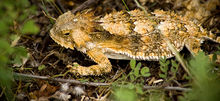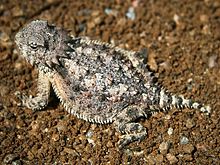Regal horned lizard: Difference between revisions
O.bengoechea (talk | contribs) added behavior section |
O.bengoechea (talk | contribs) added reproduction section |
||
| Line 27: | Line 27: | ||
==Behavior== |
==Behavior== |
||
This is a year round active type of lizard, but during winter the activity is usually restricted to unseasonably warm days. It looks for shelter from cold temperatures by digging holes in the ground. A particular characteristic is that it when it is threatened or captured it squirts blood from its eye. This blood may have a fake taste used to deter predators. Some other defensive behaviors include gulping air and poking with the horns. |
This is a year round active type of lizard, but during winter the activity is usually restricted to unseasonably warm days. It looks for shelter from cold temperatures by digging holes in the ground. A particular characteristic is that it when it is threatened or captured it squirts blood from its eye. This blood may have a fake taste used to deter predators. Some other defensive behaviors include gulping air and poking with the horns. |
||
==Reproduction== |
|||
During summer they can lay up to 33 eggs in a nest excavated in loose soil. The nest is a small chamber at the end of an 14’’ long tunnel. |
|||
==Distribution== |
==Distribution== |
||
Revision as of 05:13, 20 August 2012
| Regal Horned Lizard | |
|---|---|

| |
| Phrynosoma solare | |
| Scientific classification | |
| Kingdom: | |
| Phylum: | |
| Subphylum: | |
| Class: | |
| Order: | |
| Suborder: | |
| Family: | |
| Genus: | |
| Species: | P. solare
|
| Binomial name | |
| Phrynosoma solare | |

The regal horned lizard (Phrynosoma solare) is a horned lizard species native to Mexico and the Southwest United States.[2]
Description
The regal horned lizard is a small, flat lizard that’s about the size of the palm of your hand. Though it has spikes all around its body, the regal horn’s main defense is the ability to squirt blood from its eyes. (NML p. 20-21)
Diet
They eat mostly harvester ants, and can eat twenty-five hundred ants in one meal. They are slow eaters, because they spend most of their time in the intense heat of the desert during meals. (NML p. 20-21)
Behavior
This is a year round active type of lizard, but during winter the activity is usually restricted to unseasonably warm days. It looks for shelter from cold temperatures by digging holes in the ground. A particular characteristic is that it when it is threatened or captured it squirts blood from its eye. This blood may have a fake taste used to deter predators. Some other defensive behaviors include gulping air and poking with the horns.
Reproduction
During summer they can lay up to 33 eggs in a nest excavated in loose soil. The nest is a small chamber at the end of an 14’’ long tunnel.
Distribution
This lizard can be found across southeastern Arizona and along the transition of the southern zone of the central mountains region.[3]
Habitat
This horned lizard occupies primarily level or gently sloping terrain with openly spaced desert vegetation such as mesquite, creosote bush, and saguaro cactus.[4]
References
Nature’s Monsters: Lizards, Brenda Ralph Lewis, Gareth Stevens publishing,2006 [5]
- ^ ZipcodeZoo.com
- ^ UTexas.edu
- ^ http://www.reptilesofaz.org/Lizards-Subpages/h-p-solare.html
- ^ UTexas.edu
- ^ Lewis, Brenda (2006). Natures Monsters: Lizards. Milwaukee, WI, USA: Gareth Stevens Publishing. pp. 20–21. ISBN 978-0-8368-6363-5.
External links
